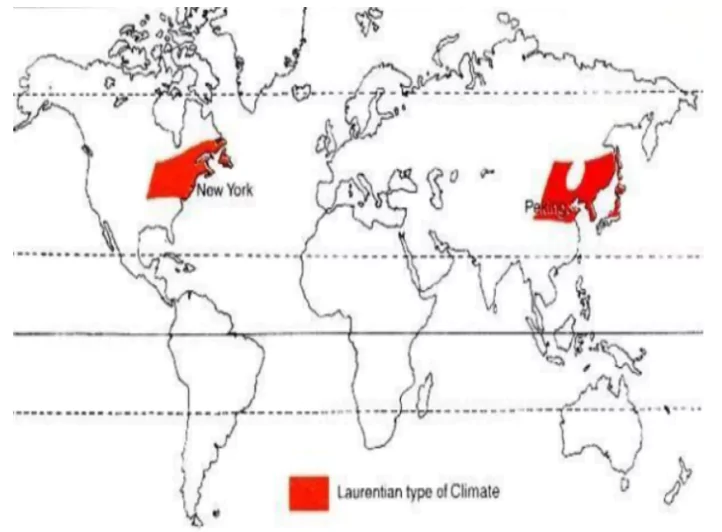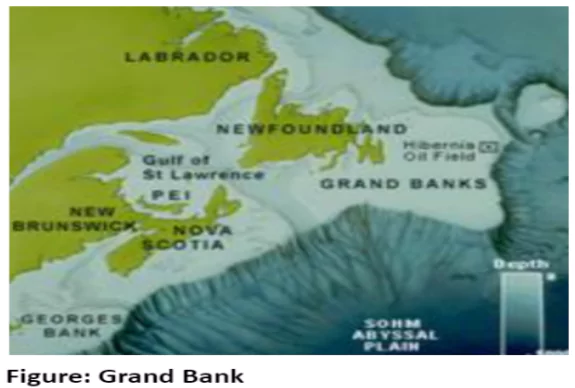Introduction
The Laurentian climate sits between British and Siberian types, blending maritime and continental features. It spans North America and Eastern Asia, shaping unique weather patterns and vegetation. Winters bring freezing temperatures and snow, while summers are warm and moist, thanks to off-shore currents. Rainfall is steady, with a summer peak due to easterly winds. The climate supports lush forests and vital economic activities like lumbering and fishing.
Overview of Laurentian Type Climate: Climate, Vegetation, and Economic Activities
Distribution

- Intermediate Type: Exhibits characteristics of both maritime and continental climates.
- Northern Hemisphere: Found in northeastern North America, including eastern Canada and the northeastern United States (Laurentian plateau, Labradoru -Quebec state, New England region of USA)
- Eastern Asia: eastern Siberia, North China, Manchuria, Korea, and northern Japan.
- Southern Hemisphere: this climate type is absent due to the limited landmass extending south of 40°S latitude.
- The equable climate and profound oceanic influence negate the presence of the Cool Temperate Eastern Margin.
- The only possible location in the southern hemisphere is In eastern Patagonia.
- the southern Andes block the Westerlies, causing aridity resulting in a rain-shadow desert with minimal rainfall
Enroll now for UPSC Online Course
Climate
- Characterized by cold, dry winters and warm, wet summers.
- Arctic Off-shore Cold Currents: are instrumental in cooling the summer, otherwise, it would have been even hotter.
- Temperature: Features of both continental and maritime climate; cold, dry winters and warm, moist summers.
- Winters: temperatures below freezing with substantial snowfall,
- Winters are cold with snowfall, particularly in areas away from maritime influences.
- Summers: can be as warm as tropical regions, moderated by off-shore cold currents.
- Summers in the Laurentian climate bring warm temperatures, occasionally reaching high levels, causing discomfort in crowded cities
- Rainfall: is spread throughout the year, with a summer peak due to easterly winds. Rainfall: 75 – 150 cm of rainfall distributed throughout the year with a maximum during summer,
- Example: Peking, in northern China, exemplifies this with seven dry months and concentrated rainfall in the summer, resembling tropical monsoon patterns.
- Northern Hemisphere: Rainfall distribution is uniform due to Atlantic influence and the Great Lakes, high temperatures in summer and snowfall in winter.
- Asiatic Region: Rainfall is far less uniform, and the rainfall regime is similar to that of the tropical monsoon type in India.
- Characterized by long, cold winters and a significant temperature range.
- Intense heating in summer creates low pressure, drawing moisture-laden winds from the Pacific Ocean and the Sea of Japan.
- Loess: Winter winds carry fine, yellowish dust, depositing it as a thick mantle of loess.
- Maritime Influence: moderates temperature ranges, with Tokyo experiencing a relatively narrow range and no months below freezing.
- Japan: receives adequate rainfall from both the southeast monsoon in summer and North West Monsoon in winter.
Vegetation
- Cool Temperate Forests: The Laurentian climate fosters cool temperate forests as the predominant vegetation, with heavy rainfall and warm summers supporting tree growth.
- North of the 50°N latitude: Coniferous forests dominate due to the length and severity of winters.
- In Siberia and Korea: coniferous forests are part of the taiga belt, sustaining the lumbering industry as a leading export.
- South of the 50°N latitude: Coniferous forests transition to deciduous forests,
- Example: oak, beech, maple, and birch trees.
- These forests have open structures and a long growing season with abundant moisture from maritime sources, facilitating rapid growth of temperate undergrowth.
- Extensive deforestation for timber extraction and agriculture has diminished their commercial value.

Economic activity
- Industries: Lumbering, timber, paper, and pulp industries are crucial economic activities in the Laurentian climate regions.
- Agriculture: takes a backseat due to harsh winters, but some hardy crops like potatoes, oats, and barley are grown for local consumption.
- The Asiatic region: produces a variety of crops such as soya beans, groundnuts, and sesame,
- North American region: Arable farming is limited, dairy farming and fruit growing are more prominent here.
- Fishing: is paramount in the Laurentian climate areas, especially off Newfoundland and the Maritime Provinces.
 The fishing industry provides significant employment and export opportunities, with modern techniques ensuring efficient harvesting.
The fishing industry provides significant employment and export opportunities, with modern techniques ensuring efficient harvesting.- The Grand Banks: of Newfoundland are among the world’s largest fishing grounds, supporting a thriving industry due to abundant plankton-rich waters.
- Example: Cod is the chief catch, haddock and halibut are other species.
- Japan: fishing is a major economic activity driven by the rich marine resources surrounding the islands.
- The Japanese heavily rely on fish as a primary protein source due to limited land resources for livestock farming.
- The indented coastline and favourable ocean currents support diverse marine life, making Japan a leading fishing nation.
- Advanced fishing technologies and research further enhance Japan’s position in the global fishing industry.
Enroll now for UPSC Online Classes
Conclusion
- The Laurentian climate offers a fascinating blend of weather conditions and natural resources. From dense forests to thriving fishing grounds, it sustains diverse ecosystems and economic activities.
- While facing challenges like deforestation and harsh winters, these regions thrive through innovation and adaptation.
- The Laurentian climate remains a crucial contributor to both local livelihoods and global industries.
![]() May 1, 2024
May 1, 2024
![]() 4239
4239
![]() 0
0


 The fishing industry provides significant employment and export opportunities, with modern techniques ensuring efficient harvesting.
The fishing industry provides significant employment and export opportunities, with modern techniques ensuring efficient harvesting.